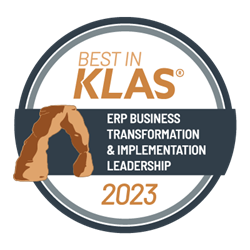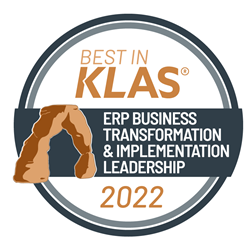In Brief
Under heightened scrutiny to extract the most value from their investments, healthcare organizations are rethinking their supply chain strategies and the technology that drives them.


To reduce costs and support new models of care delivery that include ventures into telehealth and acute care at home, organizations are developing supply chain strategies that are flexible, informed by reliable data and facilitated by digital technologies.
For years healthcare organizations have worked to optimize their electronic health record (EHR) platforms and clinical systems. Now, healthcare organizations should strive to fully integrate the EHR with their business systems, including their enterprise resource planning (ERP) system.
To begin, leaders must have a clear vision for how they will use digital technology and data to build a modern supply chain that predicts future supply needs, prevents supply shortages and optimizes strategic relationships with distributors.
Anticipating Tomorrow’s Supply Needs
It is imperative for healthcare leaders to understand how inventory flows throughout the organization in order to anticipate how supply needs could change at any time due to internal or external forces. Simply having an ERP system in place is not enough; if the system is not fully integrated into the business, it cannot utilize data to accurately capture the flow of inventory in real time. This diminishes the system’s effectiveness and prevents leaders from receiving key insights into how current, future or even unplanned events will impact inventory.
A fully integrated ERP system fed by reliable data is necessary for leaders to have full visibility into the nuances of how supplies are moved and used throughout the organization. Such visibility enables leaders to make data-informed business decisions that reduce costs and increase efficiency. Going beyond a basic tally of supplies, digital technology and data analytics can help organizations establish a materials management system that intuitively adjusts inventory needs as care delivery models evolve. For example, many organizations paused elective and nonemergency procedures to respond to the coronavirus pandemic. In such a situation, an integrated ERP system enables an organization to align supply needs with new care demands, automatically suspending or increasing relevant supply orders.
To be reliable, data needs to be not only “clean” but complete and meaningful, capturing the actual supply chain costs and full data needs of the organization and its clinicians. It is recommended that leaders establish criteria for a complete data file as well as the data governance structure and data management strategies needed to maintain reliability, completion and usefulness.
Preventing Future Supply Shortages
Though stockpiling supplies creates the feeling of preparedness, hoarding materials is not a viable strategy. An effective ERP system will inform leaders of when they need to rotate and refresh emergency stock, enabling the organization to avoid the cost of wasted materials, extend the shelf life of supplies, and adequately respond when care is most needed.
Monitoring the conditions of where supplies are being kept should also be a data-driven endeavor. Additional space, convenience and cost are just a few reasons why organizations may choose to house some supplies on-site while storing others in warehouses. However, keeping track of all the environmental factors that impact the integrity of supplies is difficult, especially when supplies are housed in different locations. Digital technologies fueled by data can alert leaders to environmental changes that degrade sensitive materials, such as rising temperatures or an increase in moisture, giving the organization a chance to adjust the storage environment before supplies become unusable.
Personal protective equipment (PPE) shortages experienced during the height of the COVID-19 pandemic are a powerful example of why it is critical for leaders to diversify their suppliers. Organizations must account for global supply-side risks and establish multiple sources for materials.
Data on where products are manufactured and the social, geographical, cultural and political challenges of the area could potentially help leaders avoid a devastating gap in deliveries. In addition to understanding their own suppliers, healthcare leaders need to understand where their competitors are sourcing supplies. If the vast majority of U.S.-based healthcare organizations receive suture packets from the same distributor and a natural disaster, pandemic or other global event prevents that distributor from moving product, every organization that relies on that distributor is negatively impacted. Predictive analytics powered by an optimized ERP system stabilizes the supply chain by helping leaders adjust product mix and distributors across geographical areas before or when disruption occurs.
Technology, Data Analytics and Evolving Distributor Relationships
The relationship between a healthcare organization and its supply chain distributors is traditionally transactional; the healthcare organization places a purchase order and the distributor fulfills it. Today, healthcare leaders can transform their businesses by establishing strategic, collaborative and technology-driven partnerships with distributors to mitigate risk, reduce costs and increase efficiency.
Next-generation inventory management starts with a strong ERP foundation and the right integration with distributors. With new levels of digital sophistication and utilization of predictive analytics, artificial intelligence and automation, distributors can remotely restock, rotate and transport supplies in real time. By converting an external distributor into an internal partner, healthcare organizations can achieve efficiencies that generate major labor and cost savings, as well as support better care delivery and clinician satisfaction. In return, distributors benefit from repeat business, more competitive contracts and metric-based bonuses.
Ultimately, data analytics is critical to getting the most value out of strategic partnerships. Leaders working on supply chain improvement may use data analytics to visualize the flow of information and supplies throughout the enterprise and work with distributors to optimize the supply chain management model.
As the industry continues to rapidly change, healthcare leaders are looking for cost-effective and efficient ways to sustain and improve their businesses. With the right business systems, technology and reliable data, leaders can maximize the use and performance of their supply chains to anticipate future supply needs, ensure availability of materials and foster mutually beneficial relationships with distributors.
KEY TAKEAWAYS
-
Think differently.
Re-imagine how EHR, ERP and other business systems should integrate to transform how supply chains operate. -
Plan differently.
Take steps to ensure ERP data is reliable enough to predict future supply needs and prevent supply shortages. -
Act differently.
Seek strategic partnerships with distributors who can support the organization’s supply chain strategy.
